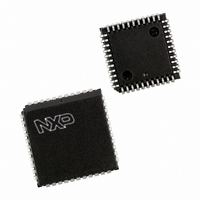P87C591VFA/00,512 NXP Semiconductors, P87C591VFA/00,512 Datasheet - Page 102

P87C591VFA/00,512
Manufacturer Part Number
P87C591VFA/00,512
Description
IC 80C51 MCU 16K OTP 44-PLCC
Manufacturer
NXP Semiconductors
Series
87Cr
Datasheet
1.P87C591VFA00512.pdf
(160 pages)
Specifications of P87C591VFA/00,512
Core Processor
8051
Core Size
8-Bit
Speed
12MHz
Connectivity
CAN, EBI/EMI, I²C, UART/USART
Peripherals
POR, PWM, WDT
Number Of I /o
32
Program Memory Size
16KB (16K x 8)
Program Memory Type
OTP
Ram Size
512 x 8
Voltage - Supply (vcc/vdd)
4.75 V ~ 5.25 V
Data Converters
A/D 6x10b
Oscillator Type
Internal
Operating Temperature
-40°C ~ 85°C
Package / Case
44-PLCC
Processor Series
P87C5x
Core
80C51
Data Bus Width
8 bit
Data Ram Size
512 B
Interface Type
CAN, I2C, UART
Maximum Clock Frequency
12 MHz
Number Of Programmable I/os
32
Number Of Timers
3
Maximum Operating Temperature
+ 85 C
Mounting Style
SMD/SMT
3rd Party Development Tools
PK51, CA51, A51, ULINK2
Minimum Operating Temperature
- 40 C
On-chip Adc
10 bit, 6 Channel
Lead Free Status / RoHS Status
Lead free / RoHS Compliant
Eeprom Size
-
Lead Free Status / Rohs Status
Details
Other names
568-1256-5
935268182512
P87C591VFAA
935268182512
P87C591VFAA
Available stocks
Company
Part Number
Manufacturer
Quantity
Price
Company:
Part Number:
P87C591VFA/00,512
Manufacturer:
TI
Quantity:
8
Company:
Part Number:
P87C591VFA/00,512
Manufacturer:
NXP Semiconductors
Quantity:
10 000
Philips Semiconductors
15.3.4
The master mode is entered in the main program. To enter
the master transmitter mode, the main program must first
load the internal data RAM with the slave address, data
bytes, and the number of data bytes to be transmitted. To
enter the master receiver mode, the main program must
first load the internal data RAM with the slave address and
the number of data bytes to be received. The R/W bit
determines whether SIO1 operates in the master
transmitter or master receiver mode.
Master mode operation commences when the STA bit in
S1CION is set by the SETB instruction and data transfer is
controlled by the master state service routines in
accordance with Table 61, Table 62, Figure 37 and
Figure 38. In the example below, 4 bytes are transferred.
There is no repeated START condition. In the event of lost
arbitration, the transfer is restarted when the bus becomes
free. If a bus error occurs, the I
enters the not selected slave receiver mode. If a slave
device returns a not acknowledge, a STOP condition is
generated.
A repeated START condition can be included in the serial
transfer if the STA flag is set instead of the STO flag in the
state service routines vectored to by status codes 28H and
58H. Additional software must be written to determine
which data is transferred after a repeated START
condition.
15.3.5
After initialization, SIO1 continually tests the I
branches to one of the slave state service routines if it
detects its own slave address or the general call address
(see Table 63, Table 64, Figure 39, and Figure 40). If
arbitration was lost while in the master mode, the master
mode is restarted after the current transfer. If a bus error
occurs, the I
selected slave receiver mode.
2000 Jul 26
Single-chip 8-bit microcontroller with CAN controller
M
M
S
LAVE
ASTER
ODES
2
C bus is released and SIO1 enters the not
T
RANSMITTER AND
T
RANSMITTER AND
2
C bus is released and SIO1
S
LAVE
M
ASTER
R
ECEIVER
R
2
ECEIVER
C bus and
M
ODES
102
In the slave receiver mode, a maximum of 8 received data
bytes can be stored in the internal data RAM. A maximum
of 8 bytes ensures that other RAM locations are not
overwritten if a master sends more bytes. If more than 8
bytes are transmitted, a not acknowledge is returned, and
SIO1 enters the not addressed slave receiver mode. A
maximum of one received data byte can be stored in the
internal data RAM after a general call address is detected.
If more than one byte is transmitted, a not acknowledge is
returned and SIO1 enters the not addressed slave receiver
mode.
In the slave transmitter mode, data to be transmitted is
obtained from the same locations in the internal data RAM
that were previously loaded by the main program. After a
not acknowledge has been returned by a master receiver
device, SIO1 enters the not addressed slave mode.
15.3.6
The following software example shows the typical
structure of the interrupt routine including the 26 state
service routines and may be used as a base for user
applications. If one or more of the four modes are not used,
the associated state service routines may be removed but,
care should be taken that a deleted routine can never be
invoked.
This example does not include any time-out routines. In
the slave modes, time-out routines are not very useful
since, in these modes, SIO1 behaves essentially as a
passive device. In the master modes, an internal timer may
be used to cause a time-out if a serial transfer is not
complete after a defined period of time. This time period is
defined by the system connected to the I
A
A
DAPTING
PPLICATIONS
T
HE
S
OFTWARE
Preliminary Specification
F
OR
D
2
IFFERENT
P8xC591
C bus.















